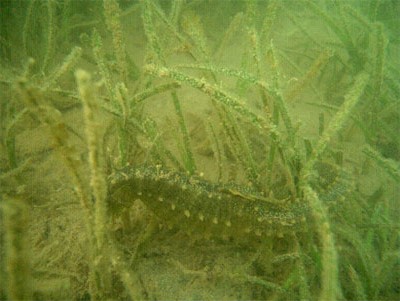
Seahorse in bay grasses. (Photo: DNR)
ANNAPOLIS (May 22, 2012)—The latest survey measuring the underwater seagrass abundance in Maryland’s coastal bays shows the plants have decreased by 35 percent in less than year. The sharp decline is believed to be the result of degraded water quality combined with an especially hot summer in 2010 - when large declines were also seen in the lower Chesapeake Bay.
“These losses are troubling to the recovery of the bays,” said Dave Wilson, executive director of the Maryland Coastal Bays Program. "We have lost nearly 20 years of seagrass recovery and the primary nursery for crabs and fish along with it. The Coastal Bays Program will continue to work with our partners to reduce nutrient and sediment pollution in order to improve water clarity and reach our seagrass goal in the bays behind Ocean City and Assateague Island."
The study, released by the Maryland Department of Natural Resources (DNR), the Maryland Coastal Bays program, the Virginia Institute of Marine Scientists and the National Park Service, showed underwater grasses dropped from 13,863 acres in July 2010, to 9,083 acres in May 2011 - levels not seen since the early 1990s. Their acreage is even less than it was during the extreme decline caused by the hot summer of 2005. A total of 4,780 acres of critical seagrass habitat was lost in bays throughout the area.
Chincoteague Bay lost the greatest acreage, 27 percent of grasses or 2,756 acres (nearly equal losses in both Maryland and Virginia). The northern bays showed the greatest percent losses: Assawoman Bay saw a 96 percent decline, or 900 acres; the Isle of Wight, 93 percent or 483 acres; and St. Martin River lost its last 1.6 acres. Seagrasses are an important indicator of clean water and serve as food and shelter for many fish and shellfish, including flounder, blue crab and bay scallops. The plants are also a vital food source for Atlantic Brant and other waterfowl during migration and over-wintering.
Low water quality is the biggest threat to seagrass recovery. Nutrient pollution fuels algae and seaweed blooms in the water which can block light to seagrass beds. Sources of nutrient pollution include air deposition, farm fields, boating, development, septic fields, parking lots and wastewater treatment plants.
“The plants essentially succumb to the ‘one, two punch,’” said Thomas Parham, DNR Director of Tidewater Ecosystem Assessment Service. “The heat alone doesn’t kill them unless combined with the already stressful conditions the plants are living in.”
“Maryland is among the states most vulnerable to climate change. Hotter summers and rising sea levels, along with increased storm intensity, could have devastating and far-reaching environmental and economic impacts on the Coastal Bays ecosystem and the quality of life Marylanders currently enjoy,” said Zoe Johnson, DNR Program Manager for Climate Policy. “The seagrasses are a great barometer of the health of the coastal bays. We must continue to reduce nutrient and sediment pollution, collectively and individually, to benefit seagrass restoration and ultimately the health of the coastal bays.”
The losses of eelgrass in Maryland’s Coastal Bays as well as Chesapeake Bay contrast with the continued expansion of eelgrass in Virginia’s Coastal Bays.
“The clearer water of the Virginia coastal bays, as well as the proximity of the eelgrass meadows to cooler ocean waters makes the exposure to stressful high water temperature conditions more bearable, allowing these meadows to persist despite the high summertime temperatures,” said Dr. Bob Orth, who oversees the annual SAV monitoring surveys.
Long-term monitoring by Assateague Island National Seashore shows current trends in nutrient conditions continue to degrade in Chincoteague Bay. However, there are some promising signs of improvements shown by data collected by Maryland Department of Natural Resources, especially in Kitt’s Branch/Trappe Creek, as a result of removing wastewater discharge from Berlin.
“It’s difficult to imagine our bays without seagrasses, but that’s the direction we’re heading without a change in the status quo,” said Trish Kicklighter, superintendent of Assateague Island National Seashore. “The majority of seagrasses in Chincoteague and Sinepuxent Bays occur in the shallow waters adjacent to Assateague Island. If we want our children and grandchildren to enjoy the benefits of a healthy park and bay system, we all need to get involved.”
Seagrass acreage is estimated through an annual aerial survey, which is flown between late spring and early fall. Additional information about the aerial survey and survey results is available at http://www.vims.edu/bio/sav/.
To see current water quality conditions visit, http://mddnr.chesapeakebay.net/eyesonthebay/statustrends_coastalbays.cfm. More information on Maryland’s Coastal Bay’s is available at http://dnr.state.md.us/coastalbays/.
Source: Maryland Department of Natural Resources


